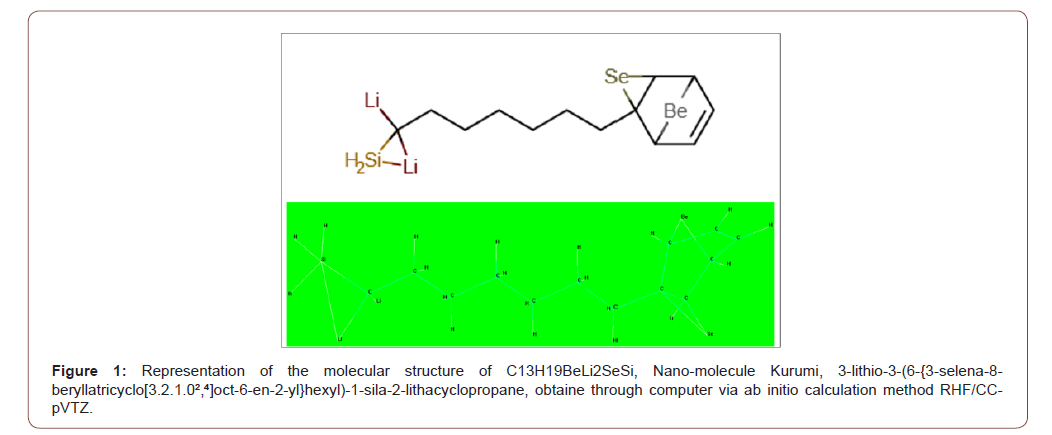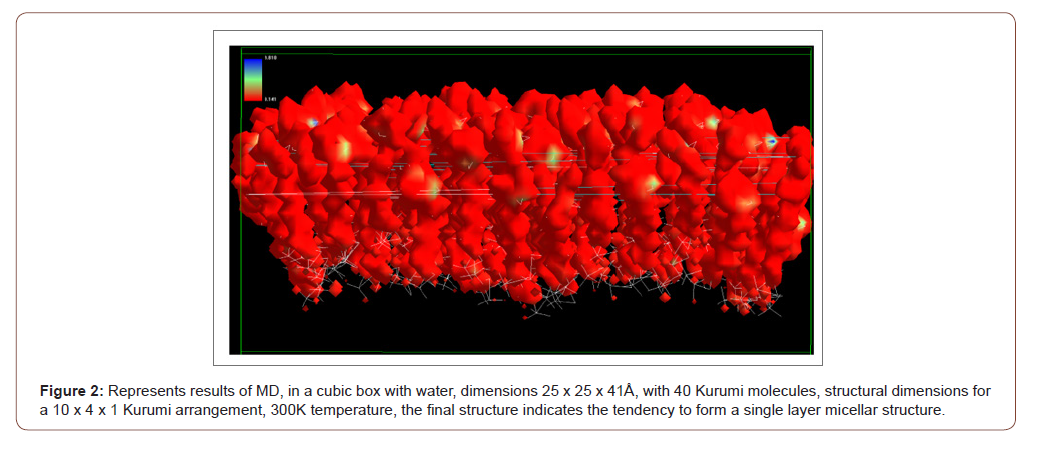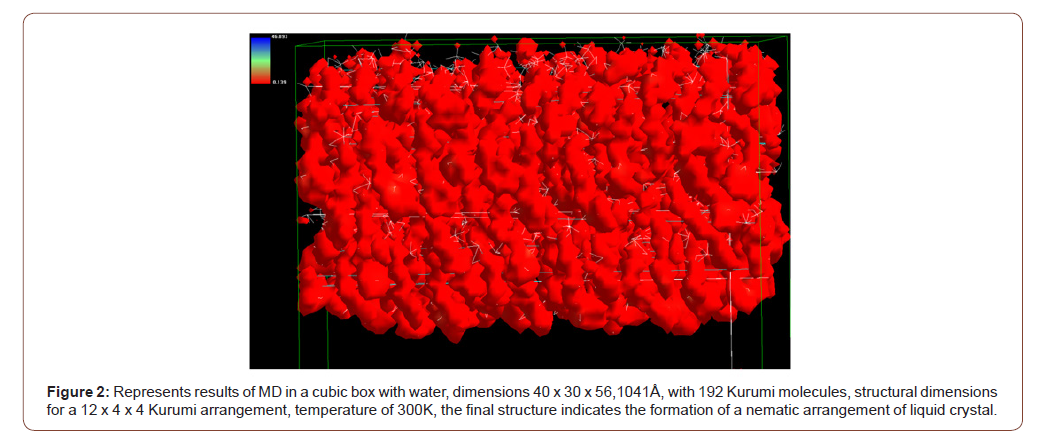 Research Article
Research Article
Bioinorganic Membrane Using A New Kurumi Liquid Crystal
Ricardo Gobato1,2*, Alireza Heidari3 and Abhijit Mitra 4
1Green Land Landscaping and Gardening, Seedling Growth Laboratory, Brazil
2Secretariat of State of Parana Education and Sport, Laboratory of Biophysics and Molecular Modeling Genesis, Bela Vista do Paraíso, Brazil
3Faculty of Chemistry, California South University, USA
4Department of Marine Science, University of Calcutta, India
Ricardo Gobato, Green Land Landscaping and Gardening, Seedling Growth Laboratory; Secretariat of State of Parana Education and Sport, Laboratory of Biophysics and Molecular Modeling Genesis, Bela Vista do Paraíso, Parana, 86130-000, Brazil.
Received Date: January 11, 2021; Published Date: January 29, 2021
Abstract
The work characterizes develop a single layer bioinorganic membrane using nano-molecule Kurumi C13H20BeLi2SeSi / C13H19BeLi2SeSi, is well characterize computationally. As its scientific name 3-lithio-3-(6-{3-selena-8-beryllatricyclo [3.2.1.02,⁴]oct-6-en-2-yl}hexyl)-1-sila-2-lithacyclopropane. The work was based on a molecular dynamics (MD) of 1ns, using the CHARMM22 force field, with step 0.001 ps. Calculations indicate that the final structure, arrangement have the tendency to form a single layer micellar structure, when molecular dynamics is performed with a single layer. However, when molecular dynamics were carried out in several layers, indicates the behavior of a liotropic nematic liquid crystal order. Kurumi features the structure polar-apolar-polar predominant. Limitations our study has so far been limited to computational simulation via quantum mechanics e molecular mechanics (QM/MM), an applied theory. Our results and calculations are compatible and with the theory of QM/MM, but their physical experimental verification depend on advanced techniques for their synthesis, obtaining laboratory for experimental biochemical. Going beyond imagination, the most innovative and challenging proposal of the work advances the construction of a structure compatible with the formation of a “new DNA”, based now on the kurumi molecule.
Introduction
The work characterizes develop a single layer bioinorganic membrane using nano-molecule Kurumi C13H20BeLi2SeSi / C13H19Be- Li2SeSi, is well characterize computationally. As its scientific name 3-lithio-3-(6-{3-selena-8-beryllatricyclo[3.2.1.0²,⁴]oct-6-en-2-yl} hexyl)-1-sila-2-lithacyclopropane [1-8]. Getting Kurumi name [8], which means boy in Tupi-Guarani language, which are indigenous inhabitants of southern Brazil. The Raman spectrum was calculated, indicating the characteristic of the bioinorganic nano-molecule genesis. Now the challenge is to build the basic structure of the bio-inorganic membrane. [6]. The kurumi seed molecule has been well characterized, [1-9] and is in accordance with the ab initio computational methods [10-14]. Now the challenge is to build the basic structure of the bioinorganic membrane. The study evolved to construct a biomembrane from the seed molecule (kurumi) [1- 8]. The calculations default already performed admit a hydrophobic and hydrophilic molecule, the basis of the formation of a micelle and or biomembrane, as the default template [9]. But kurumi molecule is polar-apolar-polar characteristic is predominant, ie. a hydrophilic-hydrophobic-hydrophilic molecule, thus presenting another standard for the construction of a biomembrane, which is even more innovative because a bioinorganic molecule [1-8]. Preliminary bibliographic studies did not reveal any works with characteristics studied here, except the works of the authors [1-9].
Methods
The software used for MD’s outside the Program, with the CHARMM22 [15] force field, in addition to HyperChem 8.0.6 Evaluation [16]. The computer used for MD was a Desktop with SUSE Linux Enterprise Desktop, AMD Ryzen 7 1800X processor, ASUS Prime A320M-K motherboard, 16GB of RAM, with 500GB SSD [17] (Figure 1).
Arguments and Results
The Figure (1) representation of the molecular structure of C13H19Be- Li2SeSi / C13H19Be- Li2SeSii, Nano-molecule Kurumi, 3-lithio-3-(6-{3-selena-8-beryllatricyclo[3.2.1.0²,⁴]oct-6-en-2-yl} hexyl)-1-sila-2-lithacyclopropane. The Figure (2) represents results of MD, in a cubic box with water, dimensions 25 x 25 x 41Å, with 40 Kurumi molecules, 1031 water molecules, (the water molecules were removed to facilitate visualization) structural dimensions for a 10 x 4 x 1 Kurumi arrangement, 300K temperature, the final structure indicates the tendency to form a single layer micellar [18,19] structure. The Figure (3) represents results of MD in a cubic box with water, dimensions 40 x 30 x 56,1041Å, with 192 Kurumi molecules, 1353 water molecules, structural dimensions for a 12 x 4 x 4 Kurumi arrangement, temperature of 300K, the final structure indicates the formation of a nematic [18,19] arrangement of liquid crystal (Figure 2 & 3).
The final structure indicates the tendency to form a single layer micellar structure, when MD is performed with a single layer. However, when molecular dynamics were carried out in several layers, indicates the behavior of a liotropic nematic [18,19] liquid crystal order. Kurumi features the structure polar-apolar-polar predominant. The orientational order of the Kurumi molecule in the micelle has the aromatic ring on the outside and the tail end with silicon and internal lithium.



Conclusion
With initial MD, in a cubic box with water, dimensions 25 x 25 x 41Å, with 40 Kurumi molecules, 1031 water molecules, structural dimensions for a 10 x 4 x 1 Kurumi arrangement, with outer radius 15Å, inner radius 11Å, 300K temperature, the final structure indicates the tendency to form a single layer micellar structure. Also form a single layer micellar structure with initial MD, in a cubic box with water, dimensions 56,1041 x 30 x 56,1041Å, with 144 Kurumi molecules, 1624 water molecules, structural dimensions for a 12 x 12 x 1 Kurumi arrangement, with outer radius 15Å, inner radius 1Å , temperature of 300K. With initial MD, in a cubic box with water, dimensions 40 x 30 x 56,1041Å, with 192 Kurumi molecules, 1353 water molecules, structural dimensions for a 12 x 4 x 4 Kurumi arrangement, with outer radius 15Å, inner radius 11Å, temperature of 300K, the final structure indicates the formation of a nematic arrangement of liquid crystal. The final structure indicates the tendency to form a single layer micellar structure, when MD is performed with a single layer. However, when molecular dynamics were carried out in several layers, indicates the behavior of a liotropic nematic liquid crystal order. The orientational order of the Kurumi molecule in the micelle has the aromatic ring on the outside and the tail end with silicon and internal lithium. Going beyond imagination, the most innovative and challenging proposal of the work advances the construction of a structure compatible with the formation of a “new DNA”, based now on the seed molecule. Limitations our study has so far been limited to computational simulation via quantum mechanics e molecular mechanics (QM/MM), an applied theory. Our results and calculations are compatible and with the theory of QM/MM, but their physical experimental verification depend on advanced techniques for their synthesis, obtaining laboratory for experimental biochemical.
Acknowledgement
None.
Conflict of Interest
No conflict of interest.
References
- R Gobato, A Heidari (2017) Calculations Using Quantum Chemistry for Inorganic Molecule Simulation BeLi2SeSi. Science Journal of Analytical Chemistry 5 (5): 76–85.
- R Gobato, A Heidari (2018) Using the Quantum Chemistry for Genesis of a Nano Biomembrane with a Combination of the Elements Be, Li, Se, Si, C and H. J Nanomed Res 7 (4): 241-252.
- R Gobato, A Heidari, A Mitra (2018) The Creation of C13H20BeLi2SeSi. The Proposal of a Bio–Inorganic Molecule, Using Ab Initio Methods for the Genesis of a Nano Membrane. Arc Org Inorg Chem Sci 3 (4).
- R Gobato, MRR Gobato, A Heidari, A Mitra (2018) “Spectroscopy and Dipole Moment of the Molecule C13H20BeLi2SeSi via Quantum Chemistry Using Ab Initio, Hartree–Fock Method in the Base Set CC–pVTZ and 6–311G**(3df, 3pd)”. American Journal of Quantum Chemistry and Molecular Spectroscopy 2(1): 9–17.
- R Gobato, MRR Gobato, A Heidari (2019) Raman Spectroscopy Study of the Nano Molecule C13H20BeLi2SeSi Using ab initio and Hartree–Fock Methods in the Basis Set CC–pVTZ and 6–311G** (3df, 3pd). International Journal of Advanced Engineering and Science 7(1): 14-35.
- R Gobato, MRR Gobato, A Heidari (2019) Attenuated Total Reflection–Fourier Transform Infrared (ATR–FTIR) Spectroscopy Study of the Nano Molecule C13H20BeLi2SeSi Using ab initio and Hartree–Fock Methods in the Basis Set RHF/CC– pVTZ and RHF/6–311G** (3df, 3pd): An Experimental Challenge to Chemists”, Chemistry Reports 2(1): 1-26.
- Ricardo Gobato (2019) New Nano-Molecule Kurumi and Raman Spectroscopy using ab initio, Hartree-Fock Method. Am J Biomed Sci & Res.
- R Gobato, A Heidari (2018) Infrared Spectrum and Sites of Action of Sanguinarine by Molecular Mechanics and ab initio Methods. International Journal of Atmospheric and Oceanic Sciences 2(1): 1-9.
- IN Levine (2003) Quantum Chemistry. Pearson Education (Singapore) Pte. Ltd., Indian Branch, 482 F. I. E. Patparganj, Delhi 110 092, India, 5th ed. edition.
- K Ohno, K Esfarjani, Y Kawazoe (1999) Computational Material Science. Springer-Verlag, Berlin.
- Paul von Ragu Schleyer (1998) Encyclopedia of computational chemistry, New York, J. Wiley, USA.
- R Gobato (2008) “Benzocaína, um estudo computacional”, Master’s thesis, Universidade Estadual de Londrina (UEL).
- R Brooks, RE Bruccoleri, BD Olafson, DJ States, S Swaminathan, et al. (1983) CHARMM: A Program for Macromolecular Energy, Minimization, and Dynamics Calculations. J Comp Chem 4: 187-217
- BR Brooks, CL Brooks III, AD MacKerell, L Nilsson, RJ Petrella, et al. (2009) CHARMM: The Biomolecular Simulation Program. J Comput Chem 30: 1545-1614.
- Hypercube (2003) Molecular Modeling System. HyperChemTM 7.5 evaluation Hypercube.
- Creative Commons (2021) (CC-BY 4.0). Wikipedia, The Free Encyclopedia URL: https://creativecommons.org/licenses/by/4.0/.
- R Gobato (2012) The Liotropic Indicatrix”, 2012, 114 p. Thesis (Doctorate in Pysics). Universidade Estadual de Londrina, Londrina.
- M Simões F, AJ Palangana, R Gobato, OR Santos (2012) Micellar shape anisotropy and optical indicatrix in reentrant isotropic—nematic phase transitions. The Journal of Chemical Physics 137: 204905.
- Gobato Ricardo, Heidari Alireza, Mitra Abhijit (2021) Bioinorganic membrane using a new Kurumi liquid crystal.
-
MS Masoud, M Sh Ramadan, A M Sweyllam, M H Al-Saify Ricardo Gobato, Alireza Heidari, Abhijit Mitra. Bioinorganic Membrane Using A New Kurumi Liquid Crystal. Insi in Chem & Biochem. 1(4): 2021. ICBC. MS.ID.000517.
-
Antitumor Activity, Novel Azole compound, Carcinoma, Swiss Albino Mice.
-

This work is licensed under a Creative Commons Attribution-NonCommercial 4.0 International License.






